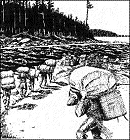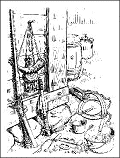The first and most important way that Europeans and Native Americans learned about each other was through trade. Each group wanted things the other had, but neither had any idea of changing the way it lived. In the end, both sides found themselves changed, breaking new trails in human development.
From the 1600s until early in the 1800s, long lines of canoes traveled every year across the Great Lakes. They carried tools, cloth and weapons that were made in England, France and other European countries. In their efforts to improve their control over their environment, the Indian people learned to depend on this new technology. [NL] |
|
|
Fur Traders

Voyageurs Enroute
Artwork Minnesota Historical Society.
From Northern Lights publication
| Voyageurs were the ordinary workmen of the fur trade. They paddled canoes and hauled heavy loads on their backs for low pay. Seldom did a voyageur become a trader. English and French ideas at that time held that a trader must be a gentleman. He should be educated and come from a well-to-do family. Most voyageurs were sons of French farmers and workers in eastern Canada. Few could read or write. |
|
Furs from animals trapped or killed in the winter months when the fur was in prime condition were the Indian’s primary trading commodity. Hides of bear, wolf, beaver, marten, fisher, muskrat, otter, mink, deer and moose were popular trading goods. The tribal men hunted/trapped and skinned the animals, and the women took care of scraping, stretching and curing the hides.
French, English and American traders competed for dominance in the fur trade. The French were a strong and persistent force, due to their early introduction to the work and their ability to adapt to Indian ways, frequently marrying into Indian tribes. The migrating Americans finally won out – through sheer numbers – as they moved westward. [NL] |
|
|

Typical Fur Trade Equipment
Artwork Minnesota Historical Society.
1963-64 Sketch by Evan A. Hart
|







